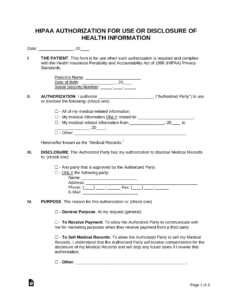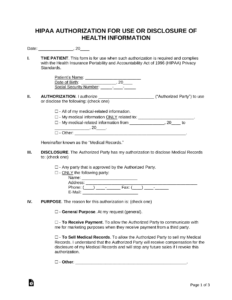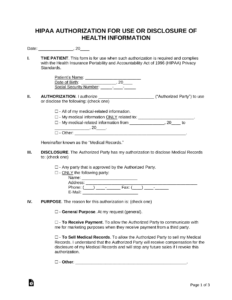The Health Insurance Portability and Accountability Act (HIPAA) is a federal law that creates national standards to protect sensitive patient health information, known as protected health information (PHI). HIPAA requires covered entities, which include healthcare providers, health plans, healthcare clearinghouses, and business associates, to implement a security policy to protect PHI from unauthorized access, use, or disclosure.
A HIPAA security policy template can help covered entities to create and implement a security policy that meets HIPAA requirements. A free HIPAA security policy template can be found on the website of the U.S. Department of Health and Human Services (HHS). The template includes sections on the following topics:
- Purpose and scope of the policy
- Roles and responsibilities for security
- Administrative safeguards
- Physical safeguards
- Technical safeguards
- Policies and procedures for workforce security
- Incident response plan
- Business associate agreements
- Documentation and training
HIPAA Security Policy Template: Administrative Safeguards
The administrative safeguards section of a HIPAA security policy addresses the policies and procedures that covered entities must implement to protect PHI. These safeguards include:
- Security risk analysis
- Sanctions for noncompliance
- Security awareness and training
- Access control
- Information system activity review
- Security incident procedures
- Disaster recovery plan
- Business associate agreements
Covered entities must implement administrative safeguards that are appropriate for the size and complexity of their organization and the nature of the PHI they create, receive, maintain, or transmit. The administrative safeguards must be reviewed and updated regularly to ensure that they are effective and compliant with HIPAA requirements.
HIPAA Security Policy Template: Physical Safeguards
The physical safeguards section of a HIPAA security policy addresses the physical measures that covered entities must implement to protect PHI from unauthorized access, use, or disclosure. These safeguards include:
- Facility security
- Equipment security
- Data backup and storage
- Media disposal
- Visitor control
- Key and lock control
- Surveillance systems
Covered entities must implement physical safeguards that are appropriate for the size and complexity of their organization and the nature of the PHI they create, receive, maintain, or transmit. The physical safeguards must be reviewed and updated regularly to ensure that they are effective and compliant with HIPAA requirements.
Conclusion
A HIPAA security policy template can help covered entities to create and implement a security policy that meets HIPAA requirements. A free HIPAA security policy template can be found on the website of the U.S. Department of Health and Human Services (HHS).
By following the steps outlined in the template, covered entities can create a security policy that will help to protect PHI from unauthorized access, use, or disclosure. This will help to ensure that covered entities are compliant with HIPAA requirements and that the privacy of patients is protected.
HIPAA Security Policy Template: FAQs
What is a HIPAA security policy template?
A HIPAA security policy template is a document that provides a framework for covered entities to create and implement a security policy that meets HIPAA requirements. The template includes sections on administrative safeguards, physical safeguards, technical safeguards, and other topics.
Where can I find a free HIPAA security policy template?
A free HIPAA security policy template can be found on the website of the U.S. Department of Health and Human Services (HHS). The template is available in Microsoft Word format and can be customized to meet the specific needs of a covered entity.
How do I use a HIPAA security policy template?
To use a HIPAA security policy template, simply download the template from the HHS website and open it in Microsoft Word. Then, customize the template to meet the specific needs of your organization. Be sure to include information about your organization’s size and complexity, the nature of the PHI you create, receive, maintain, or transmit, and the risks to PHI that your organization faces.



